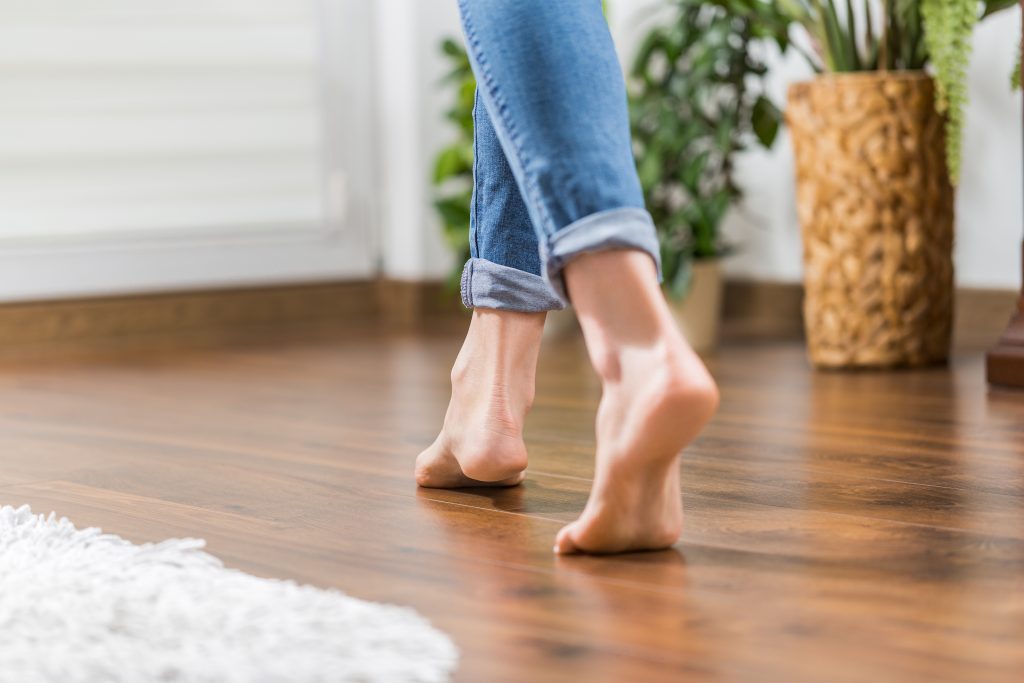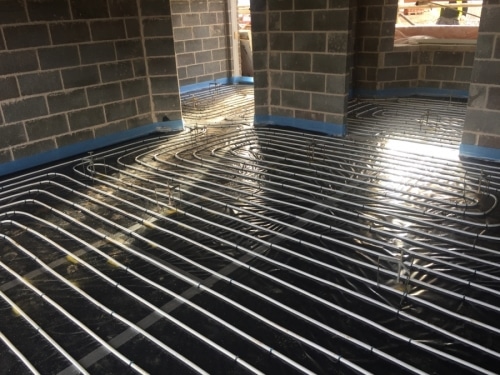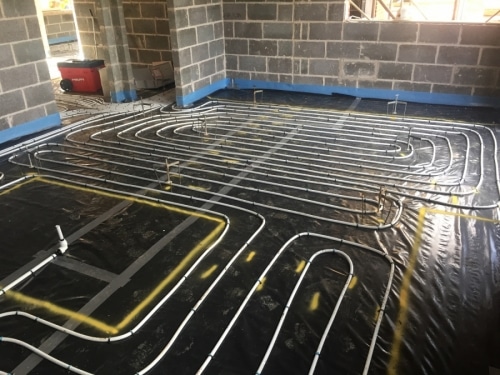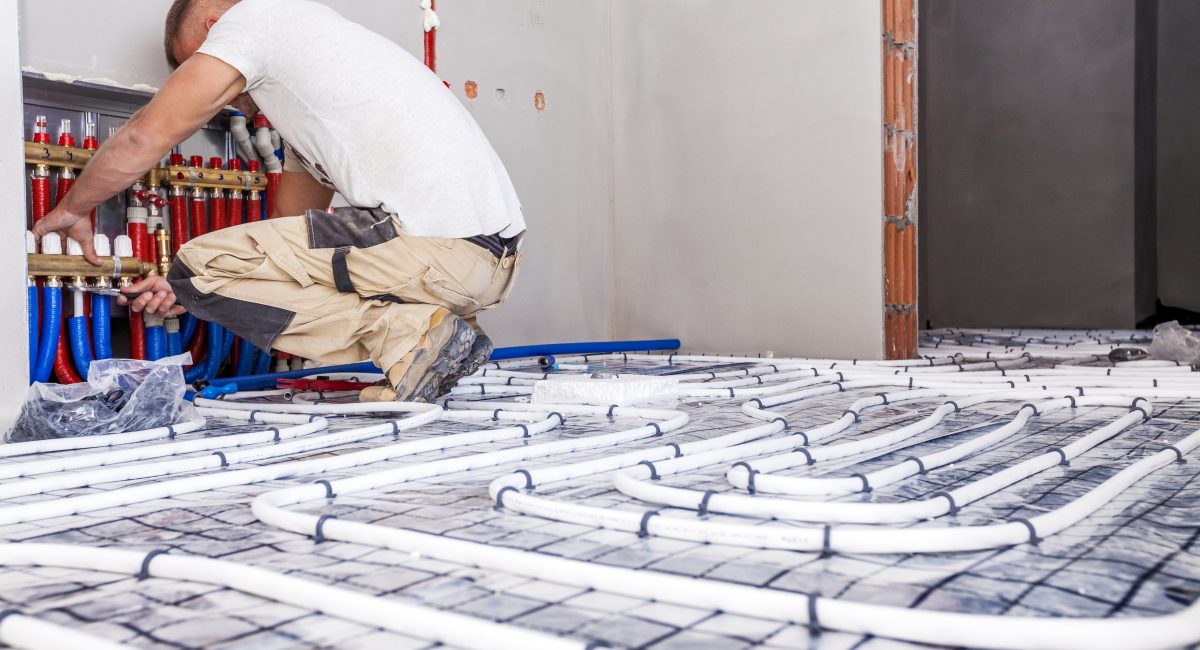Installing Underfloor Heating for a Wooden Floor: A Complete Guide
Wood flooring is a popular choice for both new build projects and retrofitting older properties, and it is often the case that homeowners and contractors have to consider whether or not underfloor heating can be installed for them. We have created this guide to provide more information on underfloor heating and wooden floors, so you can better decide whether or not the combination of timber flooring and a UFH system will be possible for your project.
Read on to learn more, or contact us today if you would like to hear more about the benefits of fitting underfloor heating systems alongside a screed layer from our team of professionals.
Can You Put Underfloor Heating Under Wooden Floors?
This is a common question, and the shortest answer is “yes”. You can put underfloor heating under wooden floors. Timber is capable of effectively transferring heat and releasing it into a room and can therefore be used as a surface if you require underfloor heating.
However, there are some stipulations to this. Different types of wood flooring have specific requirements and some will work better with UFH than others. Because of this, you must ensure you are choosing the right type of wood flooring for your project.
Can You Use UFH Systems with Suspended Floors?
It is possible to install an underfloor heating system if you have suspended floors (many older homes have these, so the UFH system would be a retrofit). It is also important to note that the installation may be more complicated.
If you intend to use a wet underfloor heating system, the floorboards will need to be lifted before the system can be installed. These will then need to be fixed back in place. If the suspended floors being worked on are above the ground floor (for instance, on the first floor) then the heating system can also be laid from underneath.
You may find certain types of hot water underfloor heating systems are designed specifically for use with suspended timber floors. These are often also designed to be fitted between floor joists. All pipework and insulation panels are fitted tightly into the void, with the pipes clipped to the insulation and grooves cut out of the battens to accommodate them.
If the system is to work effectively, it has to be as airtight as possible. A screed mix can be used between the insulation and floorboards to ensure this happens.
Some people also consider using systems that incorporate thin metal plates or chipboard mats holding pipes that are laid directly on top of the floor joists. Most of these floor systems are very thin, but they will inevitably add some height to the finished floor.
Can You Use Electric Underfloor Heating with UFH Systems?
If you would prefer to use electric underfloor heating, rather than wet underfloor heating, these systems can also be fitted underneath a wooden floor.
In the case of suspended floors, the original floorboards become the subfloor. The electric underfloor heating mats will then be laid on top; usually, this will be on a base of plywood or a suitable tile backer board. The new floor finish will then be added over the top.
You need to ensure you are buying a UFH kit or system that is designed specifically for use with solid wood, engineered wood, or laminate flooring. If there is any doubt over whether or not your kit or system fits this description, you should talk to your supplier.

Choosing the Best Wooden Flooring for UFH Systems
Two different types of wooden flooring are generally considered suitable for underfloor heating systems:
Solid Wood Flooring
Many specialists will advise against pairing underfloor heating with a solid wood floor. This is because the floorboards, once laid, are susceptible to movement when exposed to changes in temperature. However, not every type of wood is prone to this kind of reaction; checking with your supplier before you place your order can help to prevent the wrong wood from being chosen.
If your project demands solid wood flooring, most experts would recommend using kiln-dried timber with minimum moisture content (between 6% and 9%). Doing this helps the wood retain its shape during seasonal climatic changes and resist the temperature changes that come with UFH systems.
Engineered Wood Flooring
Most specialists would suggest using engineered wood floorboards, due to their strong structural design. As engineered boards are made up of layers laminated together, they are a more stable product than solid timber. The recommended board width for engineered wood that will be installed over underfloor heating is 150 mm.
Solid wood is not recommended for parquet flooring going over underfloor heating. Only engineered wood should be used.
The Benefits to Using an Engineered Wood Floor
Fitting engineered wood flooring over the top of underfloor heating comes with a range of different benefits:
- Engineered wood floors look like solid wood floors
- The construction of engineered wood makes it more stable than solid wood coverings
- Engineered hardwood flooring can be installed at any floor level, including below street level (solid hardwood floors cannot be installed in basements)
- Engineered wood flooring is often considered to provide a more high-end finish than solid wood
- It will often cost less than solid wood flooring
- It is highly durable and long-lasting

Installing Underfloor Heating Under Wooden Floors
There are several different fixing methods for installing both engineered and solid wood floors over electric and wet underfloor heating systems:
Adhesive
Adhesives can be used to bond timber floorboards to underfloor heating, providing a secure seal between the flooring and the concrete or screed used underneath. Before carrying out this method you should first check with your flooring supplier for recommended primers and adhesives.
Battening
This method involves fixing timber battens across the floor before screeding. When the screed is fully dry, the timber flooring can be attached to the battens using a screw plug or secret-nail fixing. You must take care when nailing or screwing into the battens, otherwise this could damage the floor heating pipes.
Floating
Both solid timber and engineered wooden floorboards are designed to be slotted together (usually tongue and groove style) and can be reinforced using adhesives. These floorboards can then be “floated” over the subfloor where the boards are not fixed down. This is less labour-intensive and saves time, while also making the flooring more resistant to changes in humidity and temperature.
Does Wood Flooring Need to Acclimatise First?
No matter what type of wooden flooring you are intending to use for your planned project, it will need to acclimatise before installation with underfloor heating. This helps to decrease the risk of the timber expanding or contracting once fitted.
To do this, you should lay packs of boards flat in the room that requires flooring for the time recommended by the supplier. Experts suggest that engineered wood will take around 48 to 72 hours to acclimatise. Meanwhile, solid wood can take up to 7 days depending on the wood type and manufacturer.
You should always leave an expansion gap of around 15 mm when fitting underfloor heating underneath timber flooring. This should be left around the perimeter of the room so that the floor has room to expand and contract. The gap can then be concealed with skirting boards.
Problems with Using Wooden Floors for UFH Systems
While wooden floors are highly recommended as coverings for new and retrofit underfloor heating systems, it is not uncommon for there to be problems when using them. However, as long as certain guidelines are followed, these problems can be avoided.
The most common problems and issues associated with underfloor heating and wooden floors will come from the following:
- Dramatic changes in surface temperature or hot spots in the flooring
- A lack of even heat distribution
- Extremely high humidity in a room
- Operating the heating above a surface temperature of 27°C
- Cleaning the floor using too much water
These scenarios have the potential to cause problems such as the following:
- Warped floorboards
- Delamination of engineered wood (the top layer coming off)
- Gaps appearing between floorboards
- The entire floor lifting (if the UFH system is very badly fitted)
- A lack of effective heat transference
To ensure that most of these problems do not occur, both retrofit and new underfloor heating systems should always be provided and installed by professional contractors. These people will have the knowledge and experience necessary to ensure the system is fitted correctly and can advise you on any questions or concerns you may have about the process.
Other methods of preventing problems with underfloor heating and wooden floors include:
- Not turning your underfloor heating off completely for long periods
- Not turning an off system back on and putting it back up to its previous temperature immediately (if you need to do this, do it gradually; turning the system up by a few degrees a day will allow the wood to acclimatise and balance its moisture content. The same applies to decreasing the temperature of the system)
- Clean the wood with appropriate and recommended cleaning products following the manufacturer’s instructions

The Cost of Underfloor Heating Over Wooden Floors
How much your underfloor heating and wooden floors will cost can vary greatly, depending on a range of different factors. These include the specifications of your planned work project, the materials and tools that will be used in its completion, and whether or not you will be hiring third-party contractors to install separate elements for you. This is also before you start thinking of running costs, which will be more money on top of what you’ve paid for the price of installation.
We cannot offer more information on the cost of wood flooring. However, as we are specialist providers of wet underfloor heating systems we can discuss prices and ongoing costs for these with you. Contact us directly if you would like to get started on this, or see our information on how much it costs to install and run underfloor heating.
What is the Best Flooring for Underfloor Heating?
The best types of flooring for use with underfloor heating are those that transfer heat to the floor’s surface the most effectively. This is why experts recommend that UFH systems are installed with a layer of screed over the top. When installed correctly, screed fills the gaps and spaces that surround the underfloor heating system, meaning there are no air bubbles that could disrupt the transfer of thermal energy. As a result, the heat is seamlessly and evenly distributed.
To learn more about this, please see our advice on underfloor heating and screed.
If you require another flooring layer above the screed (as it can be left exposed), or above the underfloor heating system if this is the only installation beneath, then other hard surfaces are always highly recommended. Engineered wood flooring, stone, and ceramic tiles are considered the most thermally conductive, but solid hardwood flooring also has the potential to work under the right conditions. It is also possible to install carpets, vinyl, linoleum, and resin over screed and UFH systems, though these do not transfer as much heat quite as easily.

Hiring a Professional Underfloor Heating Contractor
If you have been considering underfloor heating and screed flooring for a planned project before you finish the work by laying down wooden flooring, contact Screed It today.
We are proud of our skill and ability to fit the wet underfloor heating systems that our customers require, and we will be glad to fit yours the way that you have specified. We are also fully prepared to carry out an installation anywhere in the UK, so you can feel confident knowing you’re never out of reach of our service.
Our team will be ready and waiting to discuss what you need as soon as you get in touch. With our assistance, you will be able to make the best decisions possible for your new flooring, so you can move ahead with placing an order and move on to the next stage of your project in no time.
- Categories:
- Blog

